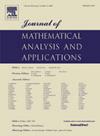Linear preservers of parallel/TEA vectors in Lp(μ) spaces
IF 1.2
3区 数学
Q1 MATHEMATICS
Journal of Mathematical Analysis and Applications
Pub Date : 2025-07-14
DOI:10.1016/j.jmaa.2025.129889
引用次数: 0
Abstract
In normed vector spaces, two vectors are parallel (resp., triangle equality attaining (TEA)) if there is a scalar ξ with (resp., ) such that . This paper characterizes linear maps preserving these pairs in and spaces, where non-strict convexity enables rich geometric structures absent in spaces, with (for which all linear maps trivially preserve such pairs). We first resolve finite-dimensional cases: -norm TEA pair preservers are matrices with at most one nonzero entry per row. For , TEA pair preservers are scalar multiples of isometries, except in . These results extend to infinite dimensional spaces , , and , where TEA pair preservers are generalized permutation operators (for ) or scalar multiples of isometries (for and ). In all cases, parallel pair preservers are either TEA pair preservers or rank one maps. Crucially, we generalize to measure-theoretic settings. For , TEA pair preservers are automatically bounded and preserves disjointness; in many interesting cases, they are weighted compositions. Parallel pair preservers combine these with rank-one maps. For , bijective preservers are scalar isometries, establishing a dichotomy: preservers reflect sparsity, while preservers align with isometric symmetries. These results unify finite-dimensional, sequence-space, and general settings, advancing the classification of structure-preserving operators in Banach spaces.
Lp(μ)空间中平行/TEA向量的线性保持器
在赋范向量空间中,两个向量x,y是平行的。,如果存在标量ξ,且|ξ|=1,则三角形等式达到(TEA)。, ξ=1)使‖x+ξy‖=‖x‖+‖y‖。本文刻画了在L1(μ)和L∞(μ)空间中保留这些对的线性映射,其中非严格凸性使得在p∈(0,1)∪(1,∞)的Lp空间中不存在丰富的几何结构(对于这些结构,所有线性映射都平凡地保留这样的对)。我们首先解决有限维的情况:1-范数TEA对保持子是每行最多有一个非零项的矩阵。对于r∞,TEA对守恒子是等距的标量倍,R2除外。这些结果推广到无限维空间l_1 (Λ), c0(Λ)和l_1∞(Λ),其中TEA对守恒子是广义置换算子(对于l_1)或等距的标量倍数(对于c0和l_1∞)。在所有情况下,并行对保存器要么是TEA对保存器,要么是排名第一的映射。至关重要的是,我们将其推广到测量理论设置。对于L1(μ), TEA对保持子自动有界并保持不连性;在许多有趣的情况下,它们是加权组合。并行对保存器将它们与一级映射结合起来。对于L∞(μ),双目标守恒子是标量等距,建立了二分类:L1守恒子反映稀疏性,而L∞守恒子与等距对称对齐。这些结果统一了有限维、序列空间和一般Lp设置,推进了Banach空间中保结构算子的分类。
本文章由计算机程序翻译,如有差异,请以英文原文为准。
求助全文
约1分钟内获得全文
求助全文
来源期刊
CiteScore
2.50
自引率
7.70%
发文量
790
审稿时长
6 months
期刊介绍:
The Journal of Mathematical Analysis and Applications presents papers that treat mathematical analysis and its numerous applications. The journal emphasizes articles devoted to the mathematical treatment of questions arising in physics, chemistry, biology, and engineering, particularly those that stress analytical aspects and novel problems and their solutions.
Papers are sought which employ one or more of the following areas of classical analysis:
• Analytic number theory
• Functional analysis and operator theory
• Real and harmonic analysis
• Complex analysis
• Numerical analysis
• Applied mathematics
• Partial differential equations
• Dynamical systems
• Control and Optimization
• Probability
• Mathematical biology
• Combinatorics
• Mathematical physics.

 求助内容:
求助内容: 应助结果提醒方式:
应助结果提醒方式:


